
Gold has had a wild ride since Trump’s surprise election win in early November. This metal first plunged then surged, ultimately making little headway. It wasn’t until mid-April that gold regained its pre-election levels. This overall lackluster gold action was confounding given all the mounting uncertainties. But it once again highlights that gold investment demand is often hostage to the US stock markets’ fortunes.
Before the election, gold surged every time Trump appeared to advance in the polls. Trump had a well-earned reputation as a loose cannon, implying far greater unpredictability. Increasing prospects of a Trump victory drove gold to $1305 the Friday before the election. But that weekend the FBI cleared Clinton again on her classified-e-mail front. So gold sold off sharply on rising odds Clinton would indeed win.
On Election Day gold closed near $1276, a price that essentially wasn’t seen again until just a couple weeks ago. As the early voting results came in that evening, Trump took a surprise lead in Florida which started to grow. As the biggest battleground state with 29 electoral votes, Florida was an absolute must-win for Trump. Gold futures soared in real-time to $1337 that evening, 4.8% over that day’s close hours earlier!
For months before that vote, all indications were gold would surge on a Trump victory. Gold investment demand grows on uncertainty, and Trump is unpredictability personified. Gold’s election-evening gains didn’t seem unreasonable, merely matching the 4.8% surge seen the day after the UK’s Brexit vote in late June that also surprised. But a couple days after Trump’s victory, gold spiraled into a 5-week-long plunge.
How could gold’s price action pivot so radically across that election as uncertainties indeed soared? It was an exceedingly-vexing outcome for gold investors and speculators, leaving them confounded and disheartened. This improbable result sprung from an equally-improbable one. Contrary to virtually all expectations pre-election, the stock markets surged in extraordinary Trumphoria after his underdog win.
Though traders often forget, gold has long been hostage to stocks. Gold is a unique asset that tends to move counter to stock markets, making it something of an anti-stock trade. So gold investment demand surges when stock markets weaken, as investors seek to prudently diversify their stock-heavy portfolios. But when stock markets surge, counter-moving gold is soon forgotten so its investment demand withers.
Given gold’s global supply-and-demand fundamentals, it’s remarkable just how dominant investment demand is in driving gold’s prevailing price levels. The definitive arbiter of gold fundamental data is the World Gold Council. It reported that global gold investment demand accounted for only 36% of overall total demand in 2016, and just 22% in 2015. Jewelry dwarfed that at 47% and 57% respectively those years.
Yet it’s not gold’s perennial largest demand category of jewelry that really moves its price, but its much-smaller investment one. Investment demand drives gold prices at the margin because it is exceedingly volatile compared to gold’s other demand categories. Between 2010 and 2016, the best jewelry-demand year was only 31% bigger than the worst one. But this same variance in investment demand was huge at 119%!
And there’s nothing that’s driven global gold investment demand in recent years like US stock-market fortunes. That sounds dubious, but the hard market data is crystal-clear. Gold investment demand surges when US stock markets weaken, and slumps when they strengthen. That’s what birthed the apparent gold anomaly after the election. Trump won, but gold demand didn’t surge because stock markets soared.
This strong inverse relationship has played out for years, but it’s often forgotten. The sole reason gold plunged between 2013 and 2015 was extreme Fed easing was artificially levitating the US stock markets. That killed gold investment demand, as there is no perceived need for prudent portfolio diversification when stocks seemingly do nothing but rally indefinitely. This same dynamic continued to play out last year.
This first chart looks at the benchmark S&P 500 stock index (SPX) and gold since early 2016. Much of if not most of gold’s price action since then can be explained by stock-market moves. While other gold drivers arise from time to time like Fed machinations, gold is hostage to stocks. That makes gold one of the best investments to own when stock markets suffer in the major bears that inevitably always follow major bulls.
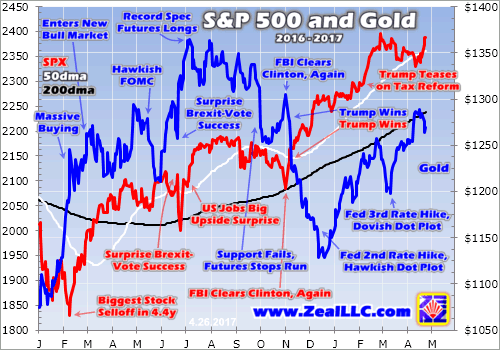
Back in mid-December 2015 leading into the Fed’s first rate hike in 9.5 years, gold was despised. The SPX was less than 3% under its all-time-record peak of 2131 seen the prior May. Complacency was off the charts, as the stock markets had fully recovered from their first correction-magnitude selloff seen in an astounding 3.6 years in August. The Fed’s extreme easing and jawboning for more short-circuited all selling.
Thus gold slumped to an extreme 6.1-year secular low climaxing a long bear. With those Fed-distorted stock markets magically powering higher month after month with no meaningful selloffs, investors didn’t want anything to do with gold. It hadn’t seen a bull market since 2011, and was left for dead. But that soon reversed after some long-suppressed SPX selling finally erupted in the wake of that initial Fed rate hike.
The SPX plunged 1.5% and 1.8% in the couple trading days after the first rate hike of the Fed’s recently-confirmed 12th rate-hike cycle since 1971. Then a few weeks later in the first week of 2016, the SPX suffered more big down days of 1.5%, 1.3%, 2.4%, and 1.1%. American traders were selling in sympathy with plunging Chinese stock markets rebelling against ill-fated new circuit breakers designed to retard selling.
Throughout January 2016, more sharp SPX down days of 2.5%, 2.2%, 1.2%, 1.6%, and 1.1% were seen. While there were some big daily rebound rallies in between, investors started to realize something was changing. The effective Fed Put they had relied upon for years to buy every dip was no longer assured with rate hikes underway. So after years of neglect, investors finally turned to gold to shore up bleeding portfolios.
The SPX ultimately dropped 13.3% in 3.3 months leading into mid-February 2016, its worst selloff seen in 4.4 years! That led to massive gold buying soon rekindling a new bull market. Note above that gold’s huge rally that month coincided exactly with the SPX’s plunge. Gold’s initial surge climaxed with a monster 4.1% daily rally the very day the SPX bottomed. A stock-market correction unleashed a new gold bull.
But out of those lows the SPX soon reversed sharply in a V-bounce. So gold’s upward progress all but ceased between mid-February and mid-April as the stock markets clawed higher again. Gold could only surge to new bull highs in late April once the SPX started rolling over again. After intensely studying this young new gold bull since its birth, I’m convinced it never would’ve happened without a major stock selloff.
As the stock markets recovered in mid-May, gold plunged on a hawkish FOMC meeting. It wasn’t until the UK’s Brexit vote in late June with its surprise outcome clobbering the SPX that gold was finally able to surge to new bull-market highs. But that renewed gold run ceased the very day the SPX managed to hit its first new record high in nearly 14 months in mid-July. Gold investment demand immediately waned.
Gold suffered a healthy correction exacerbated by a rare futures mass stopping in early October. Gold couldn’t catch a meaningful bid again until the stock markets began rolling over in October as Clinton started sliding in the polls. Then leading into the day before the election, the FBI cleared Clinton on her classified e-mails for a second time. The SPX surged sharply, driving a parallel sharp gold plunge that day.
Then contrary to expectations, the stock markets soared after Trump’s victory. With a Republican sweep of the presidency, Senate, and House, euphoria set in over fast passage of deregulation, health-care reform, and massive tax cuts. With the SPX blasting to dazzling new record highs, investors jettisoned gold they’d amassed before the election. That heavy selling persisted until mid-December just after the SPX peaked.
See the strong inverse correlation here between gold and stocks? It isn’t always mathematically precise, with gold sometimes rallying and falling with stocks instead of against them. But from a broad-brush-stroke level, gold investment demand and hence gold prices weaken when stock markets are rallying. Gold buying doesn’t materially resume until those stock rallies cease, which rekindles gold investment demand.
Gold’s latest major bottom in mid-December happened the day after the Fed hiked rates for the second time in 10.5 years. Gold fell not on that universally-expected rate hike, but the FOMC officials’ more-hawkish-than-expected forecast of three rates hikes in 2017. Despite that, gold still only started rallying again as the SPX’s raging Trumphoria surge in the election’s wake petered out. Stock markets were the key.
Gold’s newest upleg slowed considerably in early February when the SPX surged on Trump teasing of “something … phenomenal in terms of tax”. And as the SPX powered to a series of new record closes in the weeks after that, investors soon started dumping gold again. Gold didn’t stabilize and bottom until the Fed’s 3rd rate hike in mid-March confirming a new cycle. By that time the SPX’s progress had stalled again.
But investors didn’t start really bidding gold higher again until mid-April as the SPX started threatening to break below its critical 50-day moving average. Sub-50dma levels hadn’t been seen since Election Day. A 50dma breakdown after a strong, euphoric run often heralds more serious selling nearing. The prospects of the first major post-election stock selloff erupting once again rekindled gold investment demand.
Just this week this inverse relationship reasserted itself after Sunday’s presidential election in France. The results came in exactly as expected, averting the markets’ worst-case scenario of far-right and far-left candidates winning both runoff spots. European stock markets soared, rekindling stock euphoria in the US. So gold dropped sharply early this week despite a much-weaker US dollar driven by a big euro rally.
The sentiment of gold investors is heavily influenced by stock-market fortunes. They only want to buy en masse when the SPX weakens. That makes them remember diversifying their stock-heavy portfolios with gold is a wise idea. But once the SPX rebounds, that newfound marginal gold investment demand soon wanes. Because of this critical psychological link, gold is effectively held hostage by stock-market levels.
But this warring inverse relationship between gold and stocks is also fundamental, not just sentimental. This next chart looks at the physical gold bullion held in trust for shareholders of the world’s largest and dominant gold ETF. The GLD SPDR Gold Shares act as a conduit for the vast pools of stock-market capital to flow into and out of the global gold markets. GLD is the actual mechanism for stocks’ gold influence!
GLD’s mission is to mirror the gold price, but its shares have their own unique supply-and-demand profile independent of gold’s. So the only way to maintain GLD tracking of gold prices is to shunt any excess GLD-share supply or demand directly into gold itself. Thus rising GLD holdings reveal stock-market capital flowing into gold bidding it higher, while falling ones show capital leaving forcing gold lower.
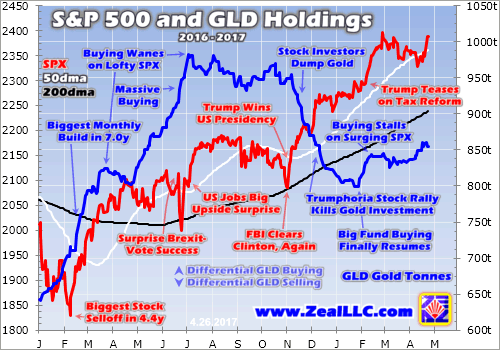
As the biggest SPX selloff in 4.4 years spawned gold’s young bull market back in early 2016, stock-market capital flooded into physical gold bullion via GLD shares. This differential GLD-share buying by scared stock investors desperately seeking diversification drove this ETF’s biggest monthly build in its holdings in 7.0 years! That heavy GLD buying by American stock investors was gold’s whole story in Q1’16.
The World Gold Council only publishes gold’s global fundamental data quarterly, so that’s the highest-resolution read available. In Q1’16 GLD’s holdings soared 176.9 metric tons. According to the WGC’s latest data published in February 2017, total global gold demand only climbed 183.8t YoY in Q1’16. Thus the heavy GLD gold buying alone accounted for a staggering 96.3% of total worldwide gold-demand growth.
That GLD buying soon stalled in mid-March as the SPX rallied sharply out of its correction low. But as the stock markets started rolling over again, differential GLD-share buying resumed in late April. That excess share demand forced GLD’s managers to issue new shares to keep GLD tracking gold. All the proceeds were immediately plowed into buying gold bullion. Excess GLD-share demand flows through to gold.
In Q2’16 GLD’s holdings climbed by another 130.8t. That accounted for an incredible 91.4% of the total 143.1t YoY growth in total world gold demand per the WGC’s latest data! Quite literally, without all that differential GLD-share buying from American stock investors there would be no new gold bull! And the driving force behind their flight into counter-moving gold was weakness in the general stock markets.
With US stock markets inexplicably surging to new record highs soon after late June’s Brexit surprise, gold investment demand evaporated. GLD’s holdings actually fell 2.1t in Q3’16. And without differential GLD-share buying pressure, global gold demand actually fell a considerable 105.3t YoY that quarter. American stock investors were still carrying the entire young gold bull at that point, there was no other real buying.
Note above in this chart that GLD’s holdings started climbing in Q4’16 before the election surprise and resulting extreme Trumphoria stock rally. But once the SPX started soaring on big-tax-cuts-soon hopes, stock investors started fleeing gold. The intense greed and complacency in the stock markets left gold relatively unattractive. Why diversify portfolios when stocks are soaring and expected to continue to do so?
So in Q4’16, GLD’s holdings plunged 125.8t. Once again, that was the entire story in worldwide gold demand. The WGC reported total global gold demand dropped 128.7t YoY that quarter, so that crazy Trumphoria-fueled mass exodus from GLD was responsible for a staggering 97.7%! You just can’t make this stuff up, these numbers are stunning. Last year, GLD was truly the entire story behind gold’s price action!
GLD’s holdings only rebounded modestly in Q1’17, up just 10.2t. And as of this writing, the WGC’s read on last quarter hasn’t been published yet. But there was evidence in the initial months of this new year that Asian investors were taking the gold-buying baton from American stock investors. Not only did gold see overnight rallies when US markets were closed, but the weak GLD build can’t explain gold’s 8.5% Q1 rally.
The key gold lesson since early 2016 is that US stock-market fortunes heavily influence if not dominate gold investment demand. So the crazy Trumphoria stock-market surge after the election is likely the sole reason why gold fared so poorly in the initial months. Despite the great uncertainties that Trump brings to the table, the perceived need to diversify portfolios waned dramatically as stocks soared on euphoria.
Thus as soon as these very-overvalued stock markets inevitably roll over into their long-overdue next bear market, gold investment demand should explode again. Gold is the best investment to own during major stock bears, as surging investment demand drives it higher while stocks fall. That’s way superior to holding traditional cash during stock bears, as gold actually grows capital while cash merely preserves it.
April’s GLD-holdings action showed gold investment demand already starting to pick up again as the latest SPX record highs of early March fade. That trend will accelerate as stock selling starts to intensify. Without the overwhelming distractions from excessive euphoria, greed, and complacency, investors will soon remember the great wisdom of prudently diversifying stock-heavy portfolios with counter-moving gold.
While gold being hostage to stocks has been bearish for it during the stock markets’ recent terminal bull years, the opposite will prove true in the coming stock-market bear years. Gold is the bear-market asset of choice, climbing when everything else is falling. GLD shares and gold itself will enjoy high demand as long as stock markets drift lower on balance. But the gold miners’ stocks will really leverage gold’s gains.
During the last secular gold-stock bull, the leading gold-stock index amplified gold’s underlying gains by 2.8x. Gold stocks can actually multiply wealth during stock bears when everything else is slowly getting mauled. This young gold-stock bull’s upside targets are radically higher than current levels, creating vast opportunities to profit greatly as this Fed-distorted freakishly-artificial stock bull faces its overdue reckoning.
Despite gold’s super-bullish stock-bear prospects, these mercurial beasts are still quite challenging to navigate. We can help with our acclaimed weekly and monthly newsletters! They draw on our vast experience, knowledge, wisdom, and ongoing research to explain what’s going on in the markets, why, and how to trade them with specific stocks. We very successfully traded through the last couple stock bears.
As of the end of Q1, we’ve recommended 928 realized stock trades in our newsletters since 2001. That includes the early-2000s and late-2000s stock bears where gold and gold stocks thrived. Including all losers, these trades’ average annualized realized gains are way up at a stellar +22.0%! Subscribe today, get informed, and start thinking, trading, and thriving like contrarians! Knowledge truly is power in the markets.
The bottom line is gold is hostage to stocks. This unique asset tends to move counter to stock markets, so gold investment demand is inversely correlated with their fortunes. Investors ignore gold when the stock markets are high and euphoric, feeling no need to diversify their stock-heavy portfolios. But once stocks inevitably start retreating, investors soon remember gold’s value and flock back to deploy capital in it.
That’s why gold suffered such heavy selling in the wake of Trump’s surprise victory. The stock markets soared on the resulting Trumphoria, killing gold demand. But as this extreme rally driven by unfounded hopes unwinds, so too will the gold-investment trends. GLD will again see heavy differential buying as investors rush to re-diversify, catapulting gold and its miners’ stocks to new bull-market highs in coming months.

Azarga Metals Corp. [TSX-V: AZR] owns a 60% interest (with a call option to move to 100%) of the Unkur Copper-Silver project (“Unkur”) in eastern Russia. Unkur is a high-grade deposit that was actively drilled and defined during the Soviet era. It had several mineral resource estimates done, but none were (are) NI 43-101 compliant. The following interview of CEO, President & Director Dorian “Dusty” Nicol conveys the excitement management has about its maiden mineral resource estimate. [Corporate Presentation] [Prior article on AZR]. Readers should note the progress (execution) of the Company since my initial interview of Mr. Nicol last year.
Peter Epstein [ER]: Please describe Azarga Metals to readers unfamiliar with the story.
CEO Dusty Nicol: Azarga Metals Corp. is a C$9 million market cap company listed on the TSX-V (ticker: AZR). It owns 60% of the Unkur Copper-Silver project in eastern Russia. We acquired the project mid-last year and have already delivered a maiden NI 43-101 Resource estimate based on the first Phase of drilling we did. It shows 42 million metric tonnes containing around 380,000 tonnes (840 million pounds) copper equivalent, (or 124 million ounces silver equivalent), in the Inferred category. We believe our maiden Resource is one of the larger ones put out by a copper or silver junior in the past few years. And, the Resource has plenty of growth potential because it’s open in multiple directions and down dip.… a very good start!
[ER]: The maiden Resource press release came as a surprise, many thought more time, money & drilling would be required. How did Azarga reach this milestone so quickly
Dusty: Yes, we get asked that a lot, there was historical exploration done on the deposit back in the 1960s / 1970s, including drilling & trenching. That work and various historical [non-43-101 compliant] resource estimates indicated that Unkur had the potential to be a copper-silver deposit of global significance, and what I mean by that is, much larger than what’s reflected in our maiden Resource. We didn’t simply ‘twin’ historical holes. We carefully considered prior exploration data and our own interpretation of the geology, and formulated a plan for the project’s first modern physical exploration program.
The presence of the historical data really improved our efficiency because it meant that the maiden Resource could be derived from only 16 diamond core drill-holes plus four trenches. Having said that, I want to emphasize that while we used historical data to guide our exploration, our Resource estimate is based entirely on our own verified data. The total spend for that first Phase leading to the maiden Resource was around US$1.5 million.
[ER]: Speaking of historical data, are there important takeaways regarding, “Soviet era” exploration drilling? How do recent drill results compare to historical records?
Dusty: Well, if we look at the areas where our new work overlapped with the old, we can honestly say that we have been pleasantly surprised by both grade and thickness. That means we’re getting increasingly confident around that notion that this could be a world-class deposit. Importantly, our Resource only covers around half of the historically known strike length. That portends plenty of potential upside. Also, we found some things that the historical data didn’t cover, for instance, there are multiple layers of ore, not just a single zone. Around a quarter of our maiden Resource comes from a second layer (referred to as Zone 2). Having a second zone, maybe multiple mineralized zones, again suggests that we could be onto something really big.
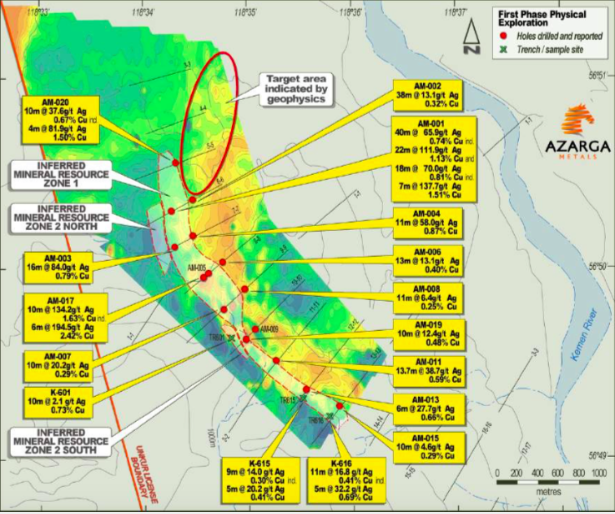
[ER]: What are some near-term catalysts over the remainder of the year?
Dusty: Before I answer directly, there’s more to say about the Resource that defines how we are moving forward. The majority of the deposit is located near surface, including two higher grade pods of mineralization, plus as mentioned, the Resource is open in multiple directions and down dip. This leads us to a two-pronged strategy. We will continue our physical exploration, which we expect will lead to a transformational increase in the Resource after our second Phase of work.
Simultaneously, we will be considering economic and engineering aspects in terms of scoping study and PEA work. So, catalysts this year include; more drilling results, results from geophysics and metallurgical testing, likely a new Resource estimate, and the results of a PEA or internal scoping study. So, there should be plenty of action and news flow! Right now we’re planning the Phase two work program and should be ready to approve and kick it off in the next 30-60 days.
[ER]:Presumably you’re comfortable with Russian country risk. What can you share with readers about your views on Russia (eastern Russia)?
Dusty: I speak five languages and as a 40-year veteran geologist, I have worked just about everywhere. I’ve worked in really hard places in terms of terrain, weather and permitting. Alaska is one — so is the high Andes of South America — but Unkur’s location in eastern Russia is not. We have no trouble getting to site or getting rigs in. The site is only 7 kilometers from a railway and it has a 220KvA powerline running over it…. Russian is fast becoming my sixth language!
By the way, I think the location has one extraordinary advantage that no one talks about, and that’s the package of incentives provided to promote investment in Russia’s far east. There are tax incentives and royalty reductions, but the most important thing is the Far East Development Fund (“FEDF”). It’s essentially a development bank specifically set up for the region. It offers debt and equity funding on preferential terms for projects such as ours. Examples of companies that are working with the FEDF include Amur Minerals, Eurasian Minerals and Polymetal Intl. Plc.
We have a strong presence in Russia. In fact, I’m the only full-time employee who’s not Russian. Our entire technical team at site and small administrative team in China is Russian. In addition, we have a strong presence in Moscow through our Moscow-based Director and his business associates & contacts. Also, a significant percentage of our shareholder base is Russian. As a result, I’m very comfortable operating in Russia and I really think that the issue of ‘country risk’ is more one of perception than one of substance. I’m finding Russia no more difficult to operate in than most other jurisdictions, and in fact in many ways I’m finding it easier.
[ER]: Azarga Metals’ press release was quite detailed, can you summarize factors (other than size, grade and jurisdiction) that readers might benefit from focusing on?
Dusty: Yes, as I said before two important features of the Resource are; (1) most of it is near surface, including the two higher grade pods of mineralization – i.e., think ease of mining and economic benefit. These pods could be amenable to lower-cost open pit mining and could be mined earlier, thus helping accelerate capital payback, and (2) it’s open in both directions along strike and down dip – i.e., think growth potential!
[ER]: Can you explain to readers the exclusive opportunity Azarga has to consolidate 100% of the project (via a call option on the remaining 40% Interest)?
Dusty: Yes, we have a call option over the remaining 40% that can be exercised if/when the Resource reaches 2 million tonnes of contained copper equivalent, with 70% in the Measured & Indicated categories. The price of the call will be either a mutually agreed upon valuation or based on an independent fairness opinion. We have a clear path to consolidate the project and are working towards the milestone to do so.
[ER] Thank you for your time and good luck on Phase 2 drilling later this year.
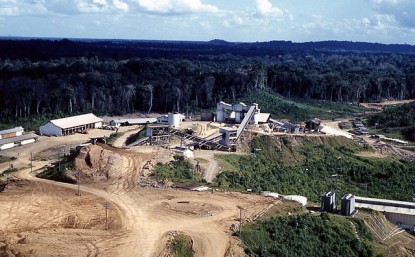
Gold’s young upleg just enjoyed a major upside breakout, bolstering strong technicals and heralding a coming Golden Cross buy signal. Investors have started aggressively buying gold again after record-high stock markets distracted them. This gold upleg’s upside momentum is really building, portending accelerating gains in coming months. Yet sentiment remains poor, with traders still quite bearish on gold.
Virtually no one is excited about gold these days. Mainstream investors continue to ignore it like usual, while contrarians largely expect a lackluster sideways grind at best. This apathy is the natural result of gold’s recent consolidation between late February and mid-April. With 6+ weeks seeing no net progress, there was little to spark any enthusiasm. Thus gold gradually faded from speculators’ and investors’ radars.
That’s exactly why consolidations and corrections exist, to rebalance sentiment. At preceding interim highs, greed grows too intense to be sustainable. So subsequent drifts or selloffs bleed off this greed, replacing it with apathy or fear. That forces out most marginal traders, paving the way for the next major rally higher. That looks to have started just over a week ago in gold, as evidenced by multiple indicators.
Gold just surged to a major technical breakout above its key 200-day moving average, which greatly strengthens its latest uptrend. Technically-oriented traders carefully watch price action relative to this most important of moving averages. 200dma breakouts following correction-magnitude selloffs are powerful buy signals. So funds have already started moving serious capital back into gold since that breakout.
Gold’s technicals and fundamentals are both very bullish, contrary to the lingering bearish sentiment still dogging this metal. Let’s start on the price-action side, since that is kindling investment demand. This first chart simply looks at gold along with its key moving averages during its young bull market birthed near the end of 2015. Gold is now in this bull’s second major upleg, and momentum is really building.
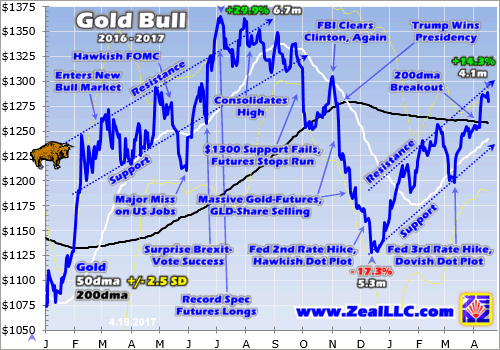
The day after the Fed’s first rate hike in 9.5 years in mid-December 2015, gold plunged to a brutal 6.1-year secular low. Everyone thought gold was doomed, convinced a zero-yielding asset simply couldn’t compete in a higher-rate environment. Yet as I discussed a few trading days before that initial Fed rate hike, gold actually thrives in Fed-rate-hike cycles historically! Gold’s young bull since again proves this out.
Gold started surging in mid-January 2016 as the US stock markets rolled over into their worst selloff in 4.4 years, a mere 13.3% correction in benchmark S&P 500 terms. Then in early February gold broke above its 200dma decisively, like it just did again in April 2017. That critical technical breakout sparked major buying by speculators and investors alike, catapulting gold across that formal +20% new-bull threshold.
That first major upleg of gold’s new bull had ups and downs, like all bull-market uplegs. A hawkish Fed crushed gold last May, but then a major miss on monthly US jobs followed by the UK’s surprise pro-Brexit vote blasted gold back up. Ultimately this metal surged 29.9% higher in just 6.7 months after being left for dead right after the rate hikes started! But that left it very overbought, drenched in greedy sentiment.
As I warned last July right after gold peaked, it faced an ominous record selling overhang from the gold-futures speculators who dominate its short-term price action. That portended a high consolidation at best or correction at worst. These both accomplish the same mission of restoring sentiment balance, but in different ways. Consolidations bleed away greed more slowly with less pain, corrections do it hard and fast.
For several months last summer the easier high consolidation came to pass, with gold drifting sideways from its uptrend’s resistance to support. But futures speculators were still excessively long using their usual hyper-leveraged bets. So when gold threatened to break below key $1300 consolidation support, the futures stop losses started tripping. That triggered more, igniting a cascading selling futures mass stopping.
That rare event hammered gold back down to its 200-day moving average for the first time since just after this new bull was born. 200dmas are the strongest and most-important support lines within ongoing bull markets, high-probability-for-success times to buy following normal healthy corrections. So gold caught a bid and surged again into early November, starting its next upleg. All this was typical bull-market behavior.
The Friday before the election, gold was back near $1305 on mounting odds Trump’s chances of beating Clinton were growing. But the following Sunday, the FBI cleared Clinton a second time on her classified e-mails. So gold plunged the Monday immediately before Election Day. For months gold had traded as if a surprise Trump win would be bullish for it and bearish for general stocks, due to soaring uncertainty.
Gold closed right at its 200dma on Election Day, and gold futures rocketed 4.8% higher that evening as Trump began taking the lead as votes were counted. But stock markets started surging on big-tax-cuts-soon hopes instead of plunging as feared on a Trump win. So demand for gold, a unique asset tending to move counter to stock markets, withered. The Thursday after the election, gold plunged through its 200dma.
That was a decisive breakdown, defined as 1%+ beyond a key technical level. Traders view 200dmas as critical demarcations between bulls and bears. Bulls are healthy as long as prices remain above their own 200dmas. But once that strong bull-market support fails, all bets are off. It impairs the assumption that a bull actually still remains in force. So technically-oriented traders start unwinding their long positions.
Thus gold plunged sharply in mid-November following that 200dma breakdown. That dragged gold’s other main moving average lower, its 50dma. 50dmas provide strong support within bulls except during major corrections, when 200dmas take over. That plunging 50dma soon crossed below gold’s 200dma in mid-November, triggering the infamous Death Cross. That’s a powerful warning signal preceding new bear markets.
Major moving-average crossovers are particularly important for futures speculators, who dominate gold’s short-term price action. These traders can run extreme leverage to gold prices approaching 30x, way over an order of magnitude greater than the 2x legal limit in the stock markets. So they can’t afford to be wrong for long, or risk catastrophic losses. Thus 200dma breakdowns and death crosses are taken very seriously.
So the extraordinary mass exodus of speculators and investors from gold in the wake of those surprise election results continued. There was massive selling in both the gold futures favored by speculators and the leading GLD SPDR Gold Shares ETF favored by investors. It was an anomalous bloodbath, which ultimately climaxed in mid-December the day after the Fed hiked rates for the second time in 10.5 years.
That extreme post-election anomaly in gold was driven by a potent combination of failing technicals and the stock markets surging to new record highs as Trumphoria reigned. But it wasn’t able to force gold’s young new bull back into bear-market territory, with a huge-but-not-bear-magnitude total correction of 17.3% over 5.3 months. Gold was again universally despised and left for dead, just like a year earlier.
Yet out of that very despair the second upleg of gold’s young bull was born. Everyone susceptible to being scared into selling low in the election’s wake had exited, leaving only buyers. Gold soon started surging sharply into the new year despite the stock markets still levitating on big-tax-cuts-soon hopes. By mid-January a new bull-upleg uptrend channel was forming. Gold’s 50dma soon stabilized and turned north.
Gold powered higher into late February, nearly regaining its key 200dma lost a couple days after the election. But then something else super-unprecedented happened, fitting in these crazy times. Futures-implied rate-hike odds for the Fed’s imminent mid-March meeting skyrocketed. They were just 22% on February 24th when gold closed near $1257, but quadrupled to 86% in just 6 trading days on hawkish Fed jawboning!
So gold-futures speculators fled for the hills on imminent-rate-hike fears, despite the fact gold has climbed an average of 26.9% during the exact spans of the previous 11 Fed-rate-hike cycles since 1971. The day before the Fed’s March meeting when rate-hike odds hit 93%, gold slumped to $1198. That was just under its fast-rising 50dma, forming the lower support of gold’s newest uptrend channel. Then the Fed hiked.
That was universally expected and fully priced in. But top Fed officials didn’t raise their forecast for the total number of rate hikes in 2017, as gold-futures speculators had feared. So gold started surging within minutes of that third Fed rate hike confirming the Fed’s 12th modern rate-hike cycle was underway. But as gold neared its 200dma again, it stalled. That key moving average also offers strong overhead resistance.
Just as prices knifing down through 200dmas from above are seen as likely signaling new bears, prices bursting through from below are seen as heralding new bulls. This isn’t always true. Though close, gold didn’t enter a new bear following its early-November 200dma breakdown. And since its young bull had never ended, it can’t be starting a new bull now. Still, 200dma crossovers motivate traders to buy and sell en masse.
After spending over two weeks leading into early April stuck just under its 200dma, gold finally surged 1.5% on the 11th and broke through. Mounting geopolitical fears motivated both futures speculators and GLD-share investors to buy aggressively. That 200dma breakout was decisive, carrying gold more than 1% above its key moving average. And once that heavy perceived resistance yielded, gold buying accelerated.
Over the decades if not centuries, 200-day moving averages have become the most-important technical line followed universally by nearly all traders. This is essentially a 10-month moving average, long enough to distill down major trends while filtering out volatile daily and weekly price noise. Prices above 200dmas are seen as being in bull uptrends, which traders want to ride. So 200dma breakouts ignite big buying.
As gold showed in February 2016, that soon becomes self-fulfilling. The more capital pouring into gold, the faster its price is bid higher. The more gold’s price rallies, the more it catches the attention of other speculators and investors who want to chase this momentum. So they too start buying in. The reason technical analysis works is because big traders move big capital based on long-proven-out price signals occurring.
So gold’s newest decisive 200dma breakout last week is likely to prove as bullish as this bull’s initial one from early last year. It changes the entire perception of gold, shifting collective sentiment from late-2016’s watch-out-for-a-bear mode to a gold-is-heading-much-higher outlook. In markets buying begets buying, regardless of what first sparked that buying. Traders just love to chase winners, so momentum builds.
And that psychological impetus to redeploy in gold is likely to soon grow much stronger. Gold is nearing a fabled Golden Cross buy signal! That’s when a 50dma crosses back above a 200dma from below. It’s one of the best-known and strongest technical buy signals, universally seen as heralding the early days of new bull markets. In gold’s case today, its nearing golden cross will prove its bull is very much alive and well.
The timing of this next golden cross depends on how fast gold keeps advancing and thus dragging its 50dma higher. Its 50dma could cross back over its 200dma within a couple weeks at best, or a couple months on the outside. Either way, that big technical event is going to really accelerate the shift in prevailing gold sentiment from bearish back to bullish. That will clear the way for much-larger capital inflows into gold.
So momentum is really building in this gold bull’s young second upleg. Interestingly this is right in line with this metal’s usual strong spring rally from mid-March to late May. After last year’s 200dma breakout and golden cross confirmed the first new gold bull since 2011, the resulting momentum was so strong gold rallied right into early July before regrouping. Gold’s technicals today are very bullish for the coming months.
The sentimental impact of this technical action has already been big enough to fuel big bullish changes in gold’s fundamentals. It’s not just futures speculators buying aggressively, but longer-term investors. This is very important for this gold upleg’s longevity, as investment buying is far more resolute. Investors are holding gold for longer time horizons, usually with zero leverage. And they control huge sums of capital.
The readiest proxy for gold investment demand is the holdings of that leading American GLD gold ETF. Unlike global gold supply-and-demand statistics which are only compiled and published quarterly, this dominant gold ETF releases its holdings daily. So they are the highest-resolution read available of what is going on in gold investment in real-time. GLD has seen big capital inflows since gold’s latest 200dma breakout.
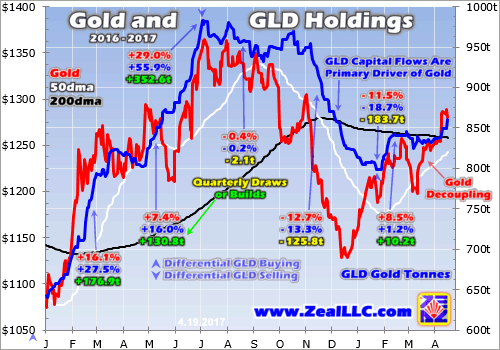
GLD’s mission is to mirror the gold price. But GLD shares have their own supply and demand totally independent from gold’s. So GLD’s price is constantly threatening to decouple from gold’s. The only way to maintain tracking is for GLD’s managers to shunt any excess buying or selling pressure on its shares directly into gold itself. Thus GLD’s physical-gold-bullion holdings rise and fall with capital flows.
In the first half of 2016, stock investors were buying GLD shares far faster than gold itself was being bought. So GLD issued new shares to supply and offset this excess differential demand. The proceeds were then immediately plowed into gold, growing the bullion GLD holds in trust for its shareholders. So quite literally, GLD is a conduit for the vast pools of stock-market capital to flow into gold. That bids gold higher.
This chart notes the quarterly changes in gold’s price and GLD’s holdings, the latter in both percentage and tonnage terms. Gold surged in 2016’s first couple quarters on stock-market capital flooding into GLD shares. Then gold stalled in Q3’16 because that differential GLD-share buying ceased. Then right after the election, heavy GLD-share differential selling emerged which drove gold sharply lower in Q4’16.
When stock investors dump GLD shares faster than gold is being sold, GLD prices face running away from gold to the downside. So that excess GLD-share supply must be sopped up. GLD’s managers raise the capital to buy back these shares by selling physical gold bullion. That directly weighs on the world gold price. Amazingly, capital flows via the American GLD are one of gold’s dominant primary drivers globally!
Realize gold is strong when investors are buying it via GLD, and weak when they are selling it through this same stock-market conduit. Following their post-election plunge, GLD’s holdings stabilized in late January and started surging again in early February. Large funds were reestablishing gold positions. But once the general stock markets started powering higher again on Trump teasing tax cuts, that buying ceased.
After those promising builds, GLD suffered draws again in early March after Fed-rate-hike odds soared. But contrarian buying drove a modest holdings rebound leading into that rate hike. Then that fund buying petered out again as gold stalled under its 200dma. Differential GLD-share buying didn’t resume until, you guessed it, gold’s 200dma breakout last week! That convinced large investors gold’s bull remains alive.
Since then, GLD has enjoyed big daily builds of 0.5%, 0.8% and even a monster 1.4% this Wednesday! The mounting technical momentum after that 200dma breakout is fueling real fundamental investment buying. Again the self-feeding psychology of rising prices argues this trend will only accelerate. The more American stock-market capital flows into gold bullion via GLD shares, the faster gold’s price will climb.
The faster gold rallies, the more investors and speculators alike will want to buy it to ride the momentum. While these lofty Trumphoria-distorted stock markets continue to retard gold investment demand, the big 200dma breakout is starting to overcome that. And the nearing golden cross will further cement the shift back to bullish sentiment. This gold upleg is really set up to accelerate considerably in the coming months!
While this gold bull itself should continue to see nice gains, they will be dwarfed by those of the leading gold miners’ stocks. The major gold miners tend to leverage gold’s upside by 2x to 3x, reflecting the outsized impact of higher gold prices on operating profits. And smaller gold miners often amplify gold’s upside even more. Gold’s bull is fueling a parallel much-larger bull in gold stocks, greatly multiplying wealth.
During roughly the first half of last year when gold powered 30% higher, the leading gold-stock index actually rocketed up 182%! Gold stocks just staged a major breakout of their own, and their bull-market upside targets are vastly higher than today’s levels. Sooner or later everyone will figure this out, and bid gold stocks radically higher. But for now they are flying under most radars, creating excellent buying opportunities.
At Zeal we’ve literally spent tens of thousands of hours researching gold stocks and markets, so we can better decide what to trade and when. We’ve long shared our work through our acclaimed weekly and monthly newsletters. They draw on our vast experience, knowledge, wisdom, and ongoing research to explain what’s going on in the markets, why, and how to trade them with specific stocks as opportunities arise.
The many new gold-stock and silver-stock trades we added in March remain low compared to their potential. It’s not too late to deploy capital in this sector. As of the end of Q1, we’ve recommended and closed 928 newsletter stock trades since 2001. Including all losers, they’ve averaged annualized realized gains way up at a stellar +22.0%! With such a great track record, you ought to put us to work for you. Subscribe today for around $10 per issue! We’ll help you learn to think, trade, and thrive like contrarians.
The bottom line is momentum is really building in this second upleg of gold’s young bull market. Despite plenty of lingering bearishness, gold just achieved a major breakout back above its key 200-day moving average. This signaled to large technically-savvy traders that gold’s bull is very much alive and well, so they are moving capital back in. This is evidenced by surging differential buying of GLD shares post-breakout.
The resulting higher gold prices are finally starting to shift gold sentiment back to bullish again. And as usual, that will become self-feeding. Speculators and investors alike love chasing winners, so buying begets buying. The more capital flows into gold, the higher its price climbs. The more gold rallies, the more traders want to buy it. This virtuous circle can run for months, gold’s new 200dma breakout is only the start.

The get-no-respect gold-stock sector is in a strong young bull market. Past gold-stock bulls have grown to utterly-massive proportions before giving up their ghosts, greatly multiplying the wealth of contrarian investors and speculators. Today’s gold-stock bull is very likely to grow vastly larger before fully running its course. Fundamental gold-stock-bull upside targets reveal the lion’s share of gains are still yet to come.
A little over a year ago in January 2016, a monstrous gold-stock bear finally climaxed. The gold miners’ stocks fell to fundamentally-absurd 13.5-year secular lows as measured by their leading index, the HUI NYSE Arca Gold BUGS Index. Out of those dark depths of despair, a new gold-stock bull was stealthily born. And it soon started flexing its muscle, rocketing 182.2% higher in just 6.5 months by early August!
Nearly tripling your capital in a half-year is one heck of a ride, leaving gold stocks really overbought. So they naturally corrected. But that selling was soon greatly exacerbated by a series of low-probability events including a gold-futures-driven mass stopping and the post-election Trumphoria stock rally hammering gold. So the HUI’s normal and healthy correction ballooned into a huge 42.5% rout over 4.4 months.
That understandably fueled excessively-bearish psychology that still persists. But this extreme sector pessimism is really distorting the big picture, blinding traders to vast opportunities. Despite that outsized correction, the HUI still blasted 64.0% higher in 2016! That’s certainly the best-performing sector in all the stock markets. And the gold stocks are no slouch in 2017 either, up 17.0% year-to-date as of this week.
In less than 15 months, the gold-mining stocks as measured by the HUI have soared 111.8% higher! In any other sector, such huge gains would be widely celebrated. But not in gold stocks, which remain too contrarian to warrant a second glance from Wall Street. Yet despite this young bull’s already-impressive magnitude, it still remains a baby in gold-stock-bull terms. A doubling for gold stocks is just getting started.
The gold stocks’ last secular bull ran between November 2000 and September 2011. During that 10.8-year span, the HUI skyrocketed an epic 1664.4% higher! While gold-stock investors enjoyed multiplying their capital by 17.6x, the leading stock-market benchmark S&P 500 slipped 14.2% over that exact span. And the gold stocks leveraged gold’s 602.9% bull-market gain during that timeframe by an excellent 2.8x.
So a near-tripling or doubling in gold stocks so far in their young new bull is nothing. This bull is still a calf, just learning to walk. It will continue to grow and strengthen, eventually maturing into yet another raging monster. Only the future will reveal how large today’s gold-stock bull will ultimately get, but its gains so far remain tiny. Still, some gold-stock-bull upside targets illuminate the great potential from here.
Speculating on upside targets is fraught with peril. As no mere mortal can predict the future, no forecast will ever prove precisely correct. So don’t make the mistake of reading too much into bull upside targets. Their purpose isn’t to luckily guess an uncertain future outcome, but to help investors and speculators understand that this gold-stock bull’s best gains are still yet to come. It’s not too late to amass large positions.
While many analysts use pure technical analysis to extrapolate trends, a stronger case for the coming gold-stock upside can be made fundamentally. The gold miners’ stocks are heading much higher not because of mere trend lines on price charts, but because higher gold prices are going to fuel explosive profits growth. Gold-mining earnings amplify gold-price gains, and this core relationship is way beyond linear.
A month ago, I looked at the actual Q4’16 results of the elite gold miners of the leading GDX VanEck Vectors Gold Miners ETF. Since its birth nearly 11 years ago, GDX has grown into the world’s dominant gold-stock trading vehicle. As GDX’s component list contains the same major gold miners as the HUI, this ETF’s price action closely mirrors that older index’s. GDX and the HUI are functionally interchangeable.
Since the gold miners haven’t yet reported their Q1’17 results, Q4’s are the newest available. During that quarter, the elite major gold miners of GDX averaged all-in sustaining costs of $875 per ounce. This AISC measure reveals true operating profitability, showing the per-ounce costs for miners to maintain and replenish operations at current levels. This real-world average AISC can illustrate profits leverage to gold.
In just-completed Q1, gold averaged $1220 per ounce. That means the major gold miners likely earned profits of $345 per ounce based on $875 AISC. Gold-mining costs are essentially fixed, mostly locked in during mine-planning stages when engineers decide which ore bodies to dig up and how to extract the gold from that rock. So higher gold prices generally don’t lead to higher operating costs, they are pure profit.
If gold rallies 10% to $1342, flat AISC of $875 imply profits of $467 per ounce. That’s big 35% growth on a mere 10% gold rally. If gold climbs 25% to $1525, gold-mining profits would soar 88% to $650 per ounce! Gold stocks are so attractive and fantastically-lucrative in rising-gold-price environments mainly because their core fundamental foundation of profitability soars so dramatically. This justifies big stock-price gains.
This ironclad relationship between gold-mining profitability and gold prices can be modeled in depth for individual gold stocks, and then combined for complex sector models. But similar results are yielded by a simple approximation. The HUI/Gold Ratio looks at the relationship between gold-stock price levels and gold prices over time. It reveals when gold stocks are overvalued or undervalued relative to gold.
While there are many ways to project gold-stock-bull upside targets, this HGR approach is my favorite. It’s easy to execute, without extensive individual-miner historical data to crunch. It’s easy to understand, with no complex math or accounting knowledge required. And most important of all, it is fundamentally-based. Gold price levels drive gold-mining earnings, and those profits ultimately drive gold-stock price levels.
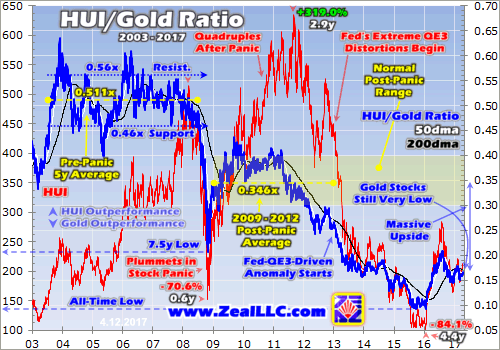
Like any indicator, absolute HGR levels don’t mean much in isolation. The HGR’s value is derived from its current position relative to historical context. And as this blue line shows, the HGR remains really low today. Over this chart’s long secular 14.3-year span, the HGR has only been lower than today’s levels for a few months over one year. Only 2015 and surrounding months saw gold stocks lower relative to gold.
That brutal gold-stock bear that ultimately birthed today’s young bull was climaxing in late 2015. Back in late September that year, the HGR fell to an extreme new all-time low of 0.093x. That exact-same level was briefly seen again in January 2016, the very day gold stocks fell to a 13.5-year secular low per the HUI. Gold stocks had never been cheaper compared to prevailing gold prices, which drive their profits!
That very week gold stocks decisively bottomed, I used this very chart to argue a major new gold-stock bull was imminent. Those gold-stock prices were truly fundamentally-absurd compared to where gold was trading, so a mean reversion higher from those extreme gold-stock lows was a certainty. And of course that’s exactly what’s happened since, this young gold-stock bull beginning that inevitable normalization.
At best in early August 2016 when gold stocks last peaked, the HUI/Gold Ratio had recovered to 0.209x. And at worst in mid-December, it collapsed back to 0.145x in that anomalous massive correction. Today the HGR is a little higher at 0.166x. But despite this young bull’s newest upleg starting to gather steam, gold stocks remain extremely undervalued relative to gold by all historical standards. This disconnect can’t last.
One of the key questions for defining gold-stock-bull upside targets is what a normal HGR level is. Over the entire span of this chart, the HGR average is 0.350x. Before the first stock-market panic in just over a century in late 2008, the HGR averaged 0.511x for a 5-year secular span. After that panic’s extreme anomalies passed, the HGR averaged 0.346x in the relatively-normal post-panic years between 2009 and 2012.
So regardless of what secular span through which the HGR is considered, it remains exceedingly low today. Gold stocks generally meander around some fair-value level relative to gold prices, where their profitability fundamentally supports their stock prices. But gold-stock prices overshoot this mean when investors get greedy and bid them too high, and then undershoot it when fear reigns and investors flee.
Visualize a straight line as the fundamentally-righteous HGR. The actual HGR is like a sine wave that oscillates around that, getting too high or too low to be sustainable late in bulls or bears. So once an extreme in either direction is hit, a subsequent mean reversion back to normal is guaranteed. And those don’t just stop at the average, but overshoot proportionally in the opposite direction from the preceding extreme.
A strong case can be made for the post-panic-average HGR of 0.346x between 2009 to 2012 being fully sustainable over the long term. Those years occurred between that wildly-anomalous stock panic in late 2008 and also-extreme gold-market distortions starting in early 2013. That’s when the Fed ramped its unprecedented open-ended third quantitative-easing campaign to full speed, levitating the stock markets.
Since gold is a unique asset that tends to move counter to stocks, investment demand wanes if stock complacency is high. Every time the stock markets looked to be rolling over into a healthy selloff from late 2012 to late 2014, top Fed officials rushed to assure traders that they were ready to expand the QE3 bond monetizations if necessary. That looked like a Fed Put on the stock markets, so dips were quickly bought.
As the stock markets surged higher from 2013 to 2015 in unnatural calm generated by the Fed, investors fled gold at dizzying rates. Gold is effectively the anti-stock trade, the ultimate portfolio diversifier. So when stock markets apparently do nothing but rally on balance indefinitely, investors feel no need to offset some of their heavy stock exposure with gold. Thus gold spiraled lower, dragging the gold stocks down.
So 2009 to 2012 was really the last time the markets functioned reasonably normally before the extreme and radically-unprecedented Fed distortions since. There is no doubt the HGR will eventually return to its 0.346x average levels from that span in its current bull. At $1275 gold, that implies a HUI level way up at 441. That’s a whopping 107% higher from this week’s levels. Think about this incredible revelation.
Even if gold does nothing, gold stocks remain so undervalued relative to their profits driven by prevailing gold prices that they still need to more than double from here! There is no other sector in all the stock markets with such amazing upside potential, with pretty much everything else greatly overvalued from the post-election Trumphoria stock surge. The near-term upside potential in gold stocks is unrivaled anywhere.
But remember market mean reversions out of major extremes never just stop at averages. Instead they first fully mean revert and then that resulting momentum keeps carrying them on to proportional overshoots. With that post-panic average of 0.346x and the all-time-low HGR last seen in January 2016 of 0.093x, that shows a massive 0.253x downside anomaly. So a temporary overshoot could hit mean plus 0.253x.
That yields a mean-reversion-overshoot HGR target of 0.599x. That wouldn’t last long and would likely mark the peak of a secular bull, when gold-stock psychology waxed exceedingly greedy nearing mania territory. Yet 0.599x isn’t unprecedented. Such levels were hit multiple times over several different years in the mid-2000s before 2008’s stock panic knocked the markets way off kilter, where they’ve been stuck since.
At today’s $1275 gold prices and a full 0.599x mean-reversion overshoot, that implies a gold-stock-bull upside target of 764 in HUI terms. That’s another 258% higher from today’s levels, incredibly enticing gains. And even that would still make for a relatively-small total gold-stock bull of 658%, merely 4/10ths the size of that last secular gold-stock bull that peaked in mid-2011. Gold-stock upside from here is vast.
But gold-stock bulls can’t grow in a vacuum, they need rising gold prices to fuel them. Not only does higher gold drive much-higher profitability which fundamentally supports much-higher stock prices, but higher gold is necessary to shift gold-stock sentiment back to bullish. Investors aren’t interested in owning gold stocks until gold has rallied far enough for long enough to convince them its own bull is sustainable.
Gold too is in a new bull market, born in mid-December 2015 after the Fed’s first rate hike in nearly a decade. Gold fell to a deep 6.1-year secular low the very next day, climaxing a major bear. Then over the next 6.7 months leading into early July 2016, gold powered 29.9% higher. That easily exceeded the 20%+ threshold necessary to declare a new bull. But 30% is nothing for a gold bull, it too remains a mere calf.
Gold’s last secular bull in the 10.4 years between April 2001 and August 2011 soared 638.2% higher. It’s hard to imagine a gold bull seeing a gain of less than 100% no matter what, which would ultimately take gold to $2102. That’s not much higher than gold’s $1894 peak in mid-2011. We’ll get to that, but let’s first consider far-more-conservative gold levels. In 2012, the last year before full QE3, gold averaged $1669.
To get back there would require a total gold bull of just 59%, laughably small by historical standards. Yet $1669 gold at that post-panic-average 0.346x HGR implies a HUI at 577 or 171% higher from here. And at the proportional-overshoot bull-topping 0.599x level, that yields a magnificently-round gold-stock-bull upside target of 1000 in HUI terms! The gold stocks would need to rally another 369% from this week’s levels.
And HUI 1000 really isn’t much of a stretch at all. That would make for a total secular bull of 893% from January 2016’s extreme secular low. That is a little over half the size of gold stocks’ last bull during the 2000s! Investors and speculators alike need to realize that enormous life-changing gold-stock gains are likely even with quite-anemic gold and gold-stock bulls by historical standards. Exceptional bulls aren’t necessary.
Finally consider gold’s bull merely ultimately doubling to $2102, which would make for one of the worst gold bulls ever. At that post-panic-average HGR, the HUI’s bull upside target is 727 which is 241% over this week’s levels. And at that proportional-overshoot HGR, this gold-stock-bull upside target rockets to an extraordinary 1259! That’s another 490% above current levels. But you don’t have to get that wild and crazy.
To see gold stocks double again from here is utterly trivial, nothing by historical standards. And if you think another doubling is probable, you should be heavily invested in this forgotten contrarian sector. Sadly even most contrarians continue to drag their feet. By the time gold stocks get exciting enough to garner real enthusiasm, the easy gains will have already been won. You want to buy before most others.
As January 2017 dawned, I wrote an essay explaining why gold stocks would shine again this year. I used this same HGR chart to illustrate why. Then in early March as gold stocks corrected hard to new-year lows, I pointed out their usual major spring rally would be starting in a couple weeks. That was a great time to buy low, so we aggressively bought and recommended superior gold-mining stocks in our newsletters.
Just last week, I explained how major gold-stock breakouts were nearing due to this sector’s sentiment and technicals. They indeed happened this week. If you’ve been ignoring this gold-stock bull’s newest upleg, or procrastinating, or too scared to buy, you’re really missing out! The markets will never give you an engraved invitation. You have to take the initiative to invest before trends mature and big gains are already won.
The gold stocks are really heating up, so it’s imperative to start following this sector now. It wouldn’t surprise me one bit to see the HUI’s 2017 gains approach or exceed its big 64% surge last year. The earlier you get informed and get deployed, the greater your odds of enjoying wealth-multiplying gains in this sector that can give your family a brighter future. You gotta be in it to win it, fortune favors the bold.
A cheap and easy way to start is through our acclaimed contrarian newsletters. They draw on our vast experience, knowledge, wisdom, and ongoing research to explain what’s going on in the markets, why, and how to trade them with specific stocks. Both our weekly and monthly are priced around $10 per issue in subscriptions, because everyone should have the opportunity to think, trade, and thrive like contrarians.
We’ve literally spent tens of thousands of hours researching gold stocks and markets, so we can better decide what to trade and when. As of the end of Q1, this has resulted in 928 recommended newsletter stock trades since 2001. Including all losers, their average annualized realized gains are way up at a stellar +22.0%! With such a great track record, you should put us to work for you. Subscribe today and get 20% off!
The bottom line is this gold-stock bull’s upside targets remain radically higher than today’s levels. Even if these young gold and gold-stock bulls prove exceptionally small and anemic by historical standards, the gold-mining stocks are still heading hundreds of percent higher from here. Another double in this sector is all but certain, something that can’t be said for any other sector in these overvalued stock markets.
As gold itself continues mean reverting higher in its own bull, investor interest in owning gold stocks will only grow. As gold-mining profits amplify gold’s gains, much-higher gold-stock prices are fully justified fundamentally. And as usual in any bull market, the earlier investors buy in the bigger their ultimate gains will prove. Both this young gold-stock bull and its newest upleg are the real deal, any doubts are past.

Precious metals ended a quiet week with quite a reversal. Gold surged above its 200-day moving average for the first time since November, only to lose the gains and then close below the 200-day moving average. Silver was already trading above its 200-day moving average before it moved higher but it then reversed strongly and even below its 200-day moving average. The miners, which have been much weaker than the metals were mostly unchanged but after opening higher. Today’s bearish reversal could signal an imminent decline in the entire complex or just signal that more time is needed before the next attempt at a breakout.
As you can see below, the metals reversed course as the 10-year Treasury yield formed a very bullish reversal around key 2.30% support. Precious metals have been tightly correlated to falling bond yields and today provided more evidence of that. It is also a concern that the metals formed their reversals at the 200-day moving average. Gold went from below to above then back below while Silver started the day above its 200-day moving average but closed below it, at $17.99. (Note, there appears to be a data error in the Silver chart).
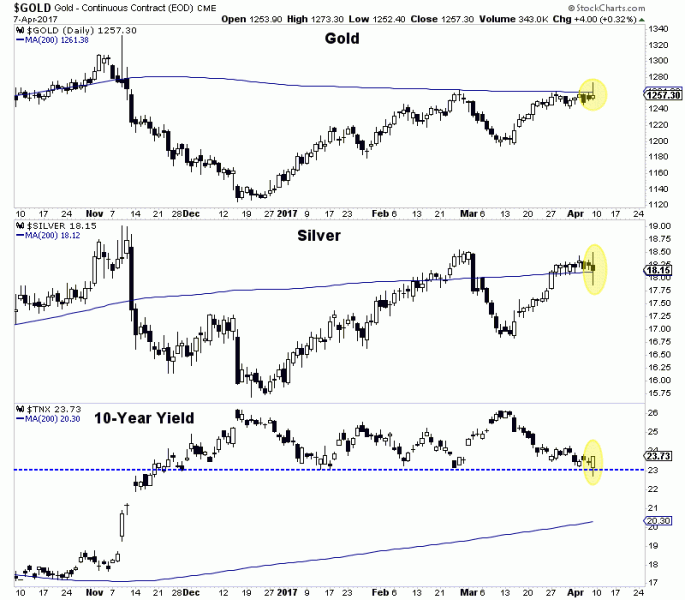
Turning to the miners, we see increased risk for an immediate decline. The failure and reversal in the metals is one reason. Another reason is the failure in the miners to hold Friday’s opening strength. At the open, GDXJ appeared to be breaking out of its triangle and GDX appeared to be breaking out from its flag formation. From false moves come fast moves and therefore we must be wary of selling in the miners next week. In particular, focus on GDXJ’s trendline support (blue arrow). If that breaks, GDXJ could test its March lows.
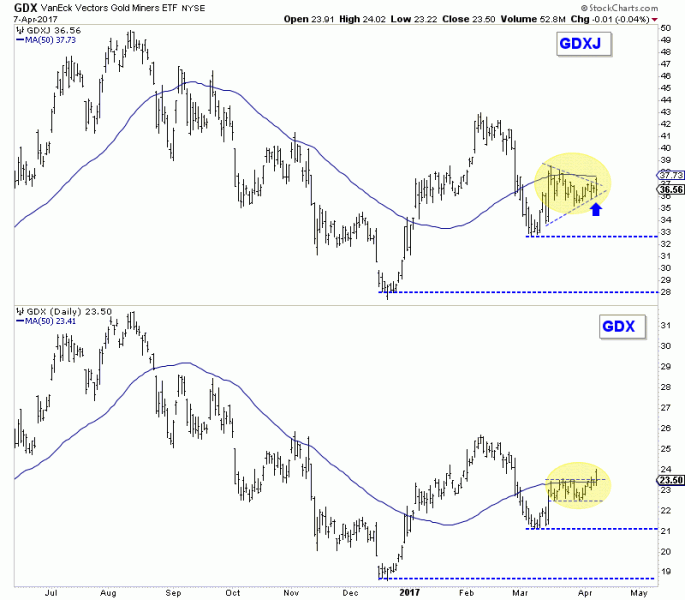
Precious metals traders and investors should be on guard for more weakness in the days and weeks ahead. We certainly have been early with this call but Friday’s bearish reversal could be the catalyst that starts the decline. Metals and miners would need to close above today’s open to invalidate this analysis. Today’s reversal in the metals was not a surprise given recent relative weakness in the miners. For precious metals bulls and speculators, continue to be patient and wait for more weakness. For this year we want to buy weakness, not chase strength. We continue to look for high quality juniors that we can buy on weakness and hold into 2018.

At the close of US trading Monday April 3, gold futures remained 1% below their three-month high from Monday of last week. Since dipping into the $1190s on March 10 however, the price for one ounce of gold is up 4.8%. So far in 2017, the US dollar index has traded 1.5% to 4.8% below its January 3 high of 103.82. Talk of rate rises by key Fed officials, however, kept the dollar’s slide from worsening further.
Throughout the fourteen years shown in the Dollar Purchasing Power chart below, the purchasing power of the US dollar has dropped by 25%. Back in 2007, one US dollar could buy 87% of the things it could in 2003, and now it has remained at 75% since 2014. Retirement account contributions typically slow during recession years, as they did from 2007 to 2009. Rising consumer prices could have a similar effect if wage inflation doesn’t keep up.
The gold IRA and precious metals pricing information on the page with the original chart shows the same plateau in purchasing power since 2014, resulting from a change in monetary policy since the first round of quantitative easing (QE) in the US started during the 2008-09 recession.
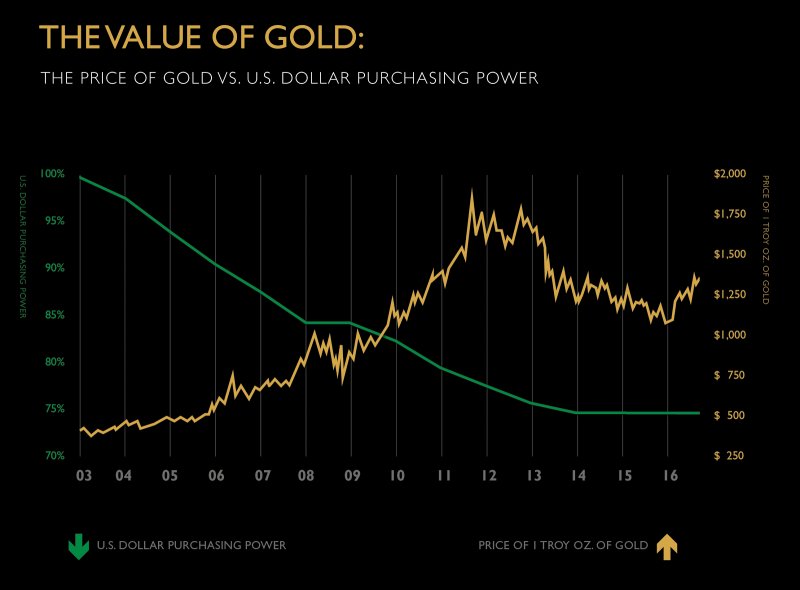
Since the last round of QE ended in October 2014, the United States Fed has been looking for signs to raise rates, and strengthening economic factors have given it a reason to do so.
That is, according to what Chicago Fed President Charles Evans said Monday March 27, when he told Bloomberg he was expecting as many as three rate hikes in 2017. Ever vigilant to changing economic conditions however, Evans said this depended on inflation expectations remaining strong, and that any change from positive trends would take his expectation down to only two rate hikes this year. That same week, Dallas Fed President Robert Evans had a dovish tone, speaking about adjusting the pace of rate hikes to ease off monetary accommodation gradually. He also mentioned the need to keep an eye on inflation though, saying that tightening will continue to occur before the Fed reaches its 2% inflation mandate.
Philadelphia Fed President Patrick Harker expressed dovish comments this week as well, reaffirming on Monday April 3 other officials’ comments about scaling back the Fed’s portfolio of Treasury bonds and mortgage-backed securities. Last Friday, William Dudley, the President of the New York Fed, said that the $4.5 trillion dollars of assets amassed during the Fed’s QE programs would be allowed to mature rather than be sold off abruptly.
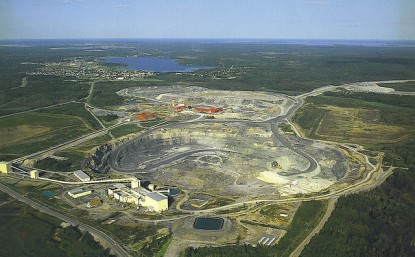
Precious metals closed the first quarter with solid gains. Gold gained almost 9% while Silver gained 14%. The miners (GDX and GDXJ) gained the same amounts (9% and 14%) but unlike the metals which closed at their highs of the quarter, ended up losing more than half their gains. Despite a strong quarter, the entire complex remains below the February highs and 200-day moving average (ex Silver) just days after the US Dollar index rebounded strongly from its own 200-day moving average. As the second quarter begins, the warning signs for precious metals are mounting.
It is never a good sign when Gold is the strongest part of the sector and especially while the sector trades below key moving averages. While Silver rests above its 200-day moving average and has recently outperformed Gold on a percentage basis, unlike Gold it has yet to reach its late February highs around $18.50. So in that respect Silver has lagged Gold. Meanwhile, the miners have not even come close to returning to their 200-day moving averages or February highs. They first reached their 200-day moving averages ahead of the metals and also began their correction first.
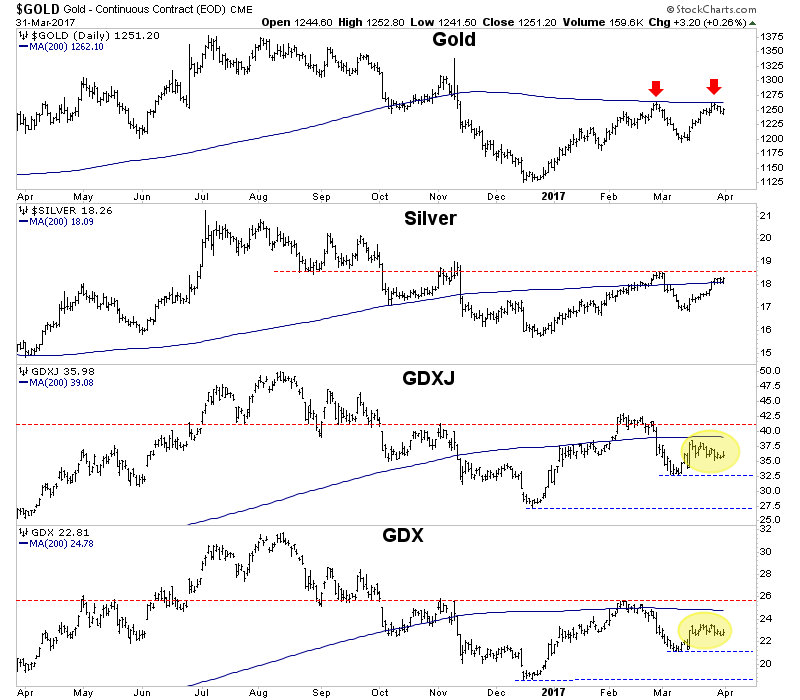
Gold is the strongest part of the sector but we see evidence it could weaken during the start of the second quarter. Gold has already failed twice at its 200-day moving average and now it must contend with a rebound in the US Dollar index. Last week the greenback enjoyed a strong rebound off its rising 200-day moving average. Furthermore, note that since December the greenback retraced only 38% of its advance from 92 to nearly 104. The strongest trends will retrace usually 38% or 50% of previous gains. Finally, while Gold against foreign currencies (Gold/FC) is quite strong from a bird’s eye view, it is currently showing a negative divergence to Gold as it is below its late February high. If Gold/FC is weaker than Gold it means that Gold is more vulnerable than usual to a rising US Dollar.
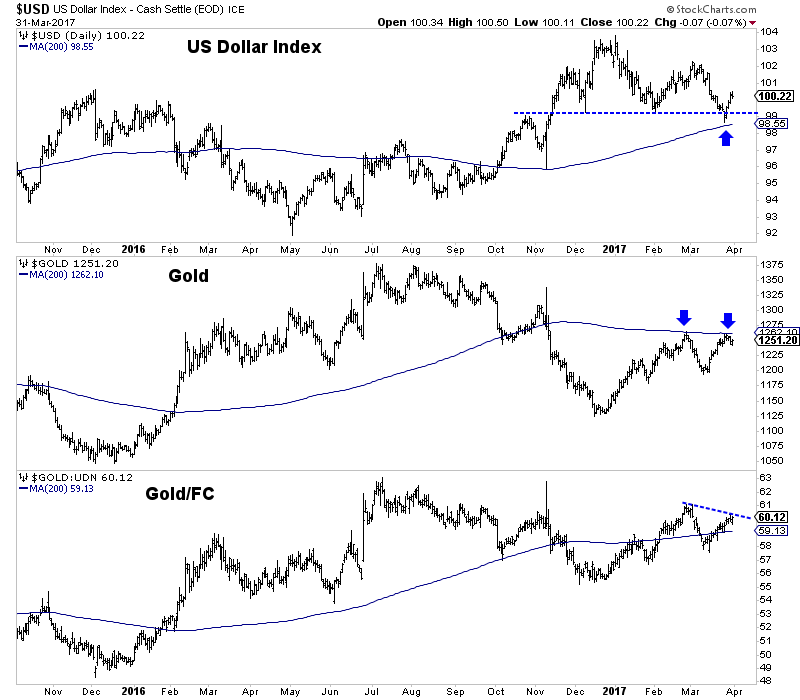
As the second quarter begins, there are critical warning signs for precious metals. The miners typically lead the metals and their recent failure to return to their 200-day moving averages and February highs is a bad omen for the metals. In addition, last week we covered the GDX advance decline line which is so weak it couldn’t even come close to its 50-day moving average. Meanwhile, the US Dollar’s strong rebound off its 200-day moving average will provide additional resistance to Gold. Given that Gold is currently the strongest part of the sector, that is not good for the entire sector. We expected 2017 to be a grind. Be patient and if precious metals turn lower, wait to buy bargains amid oversold conditions. We continue to look for high quality juniors that we can buy on weakness and hold into 2018.
If you would like to receive our free newsletter via email, simply enter your email address below & click subscribe.
CONNECT WITH US
Tweets
Tweet with hash tag #miningfeeds or @miningfeeds and your tweets will be displayed across this site.
MOST ACTIVE MINING STOCKS
Daily Gainers
 Lincoln Minerals Limited Lincoln Minerals Limited |
LML.AX | +125.00% |
      |
GCR.AX | +33.33% |
      |
CASA.V | +30.00% |
      |
AHN.AX | +22.22% |
      |
ADD.AX | +22.22% |
      |
AZM.V | +21.98% |
      |
NSE.V | +21.05% |
      |
DYG.V | +18.42% |
      |
AAZ.V | +18.18% |
      |
GLA.AX | +17.65% |


 Follow us on Twitter
Follow us on Twitter Become our facebook fan
Become our facebook fan








